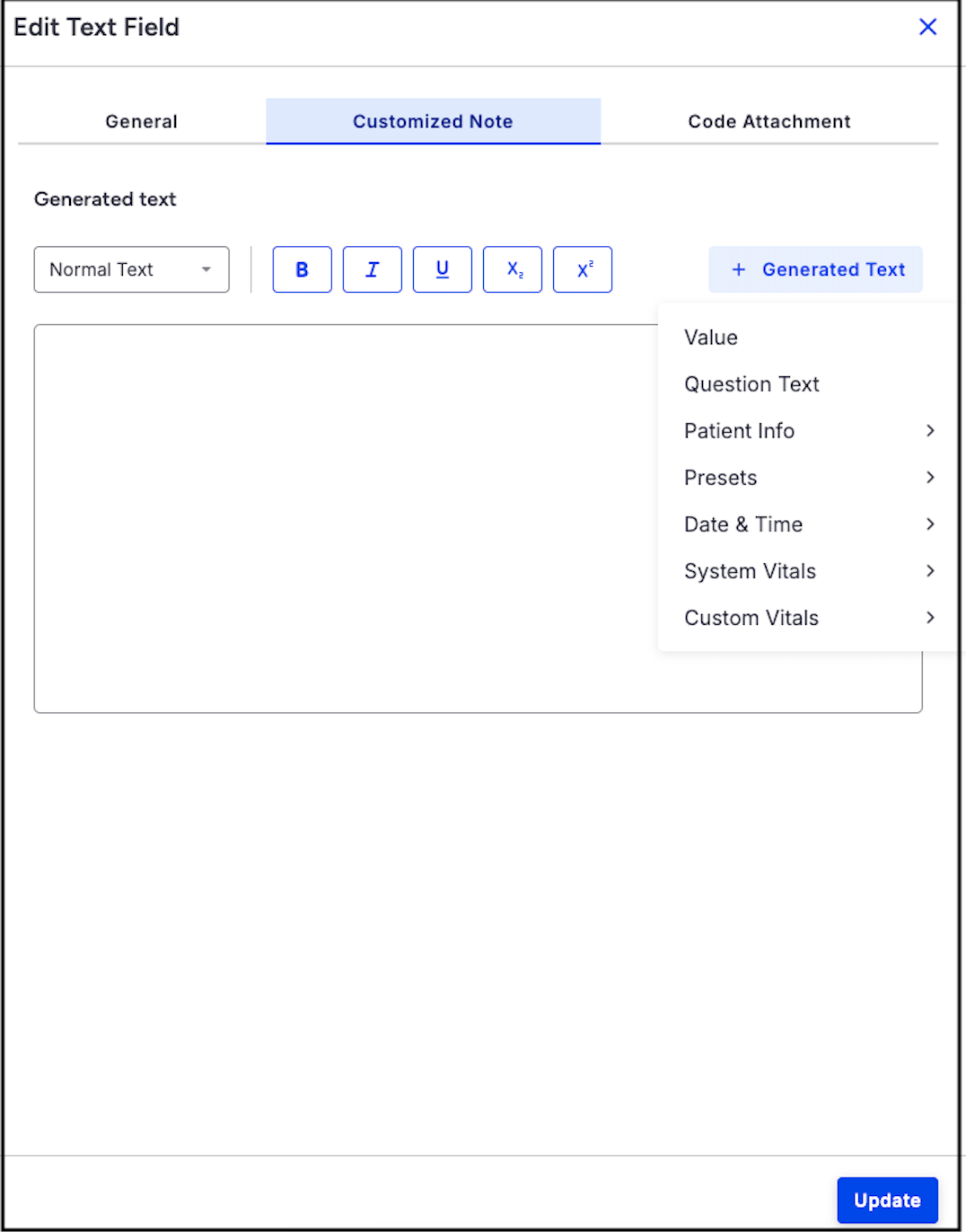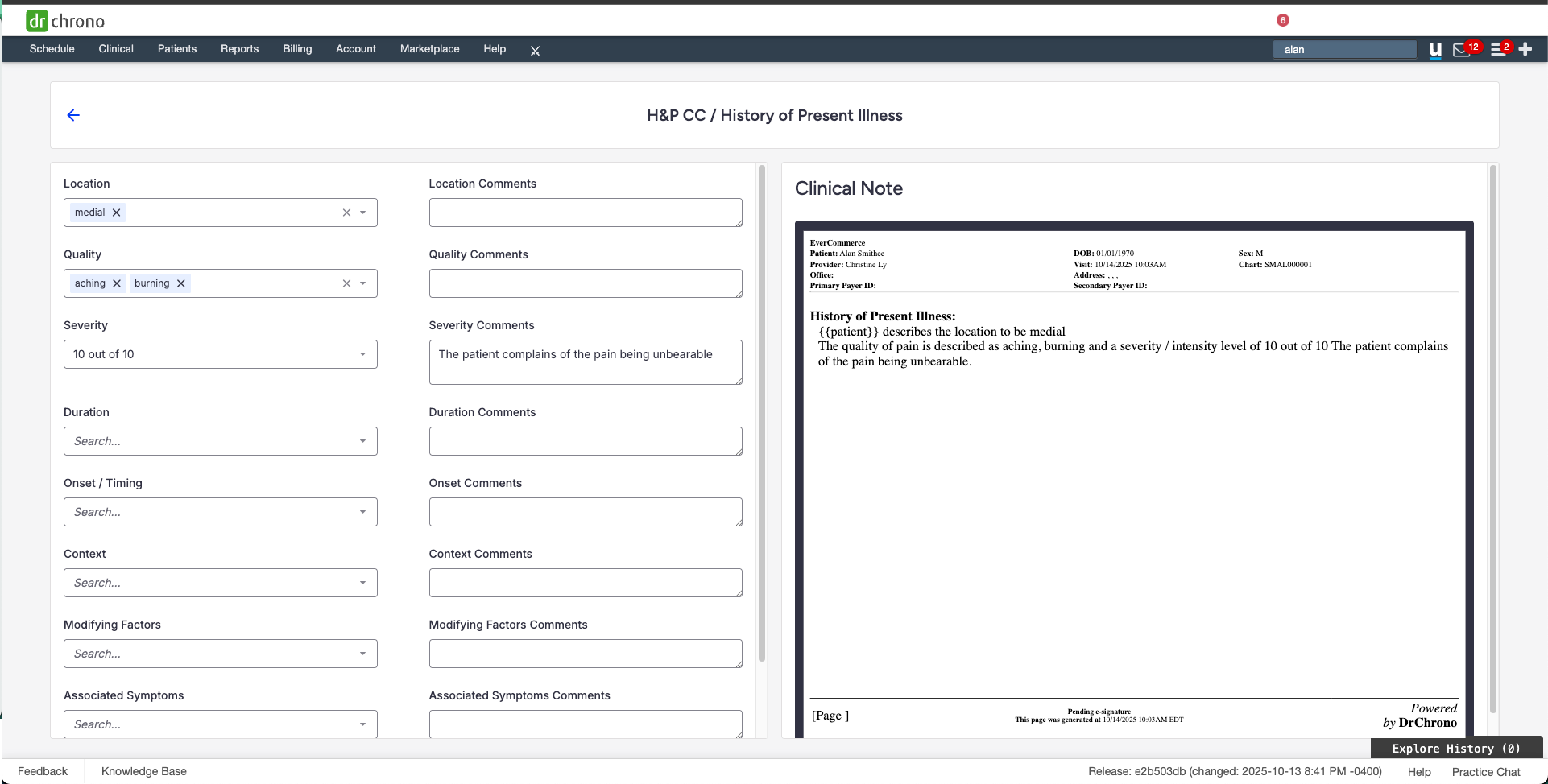Beginning in January 2026, we will start retiring the legacy Form Builder. Learn more about this update.
Clinical Form Management offers an improved workflow for creating and managing custom clinical templates. It includes enhanced features that streamline the form-building process. Both the updated and original form builders remain available and operate in parallel to support your preferred workflow.
Clinical Form Management is currently only supported on Google Chrome.
| Existing forms | Create a custom form |
| Custom form best practices | Preview form |
| Archive form | Share form |
Searching and Managing Existing Forms

To view and manage your forms:
- Navigate to Clinical > Form Tools > Clinical Form Management from the main menu.
- Search by name or Search by tags
- Using the Name Column:
- Forms are listed alphabetically by default.
- Use the up/down arrows to sort A–Z or Z–A.
- Use the search box to filter by form label.
- Using the Last Modified Column:
- Click the up/down arrows to sort forms by the most recent edits.
- Using the Action Column :
- Click the icons to:
- Edit a form
- Archive a form
- Open the Options menu for additional actions
- Only one form can be set as the default form at any time.
- Click the icons to:
Custom Form Building
Creating a Custom Form
Changes are automatically saved as you build your form.
- Navigate to Clinical Form Management
- Go to Clinical > Clinical Form Management to begin building a new custom form.
- Create a New Form
- Select New Form.
- A blank form will appear in the center canvas.
- Label the Form
- Click Options > Edit Form Info.
- Enter a form name, then select Update.
- Once named, you can begin adding form elements.
Building Your Form
- Add Form Elements
- Open the Form Elements tab.
- Drag and drop desired field tools into the Add Here sections of the form.
- Add Field Rows
- Hover between two field rows.
- Click the plus (+) icon to insert a new field row.
- Manage Field Boxes
- Hover over any field box to reveal quick action icons:
- Edit the field
- Copy the field to clipboard
- Delete the field
- Hover over any field box to reveal quick action icons:
Character Count for Single & Multi-Select Form Fields
A character counter appears below each answer option in single select and multi-select form fields. The counter updates in real time as you type, showing the number of characters used out of the 950-character limit (for example: 125/950).
Each option is limited to 950 characters to ensure consistent formatting.
If you exceed this limit:
- The field is outlined in red.
- An error message appears: "Please adjust field value to be 950 characters or less."
- You won't be able to save the form until all options meet the character limit.
Resizing Free Draw Images for Clinical Notes
You can control the size of free draw images to ensure they fit properly in your clinical note PDFs. When setting up your form, you can choose from the following preset image sizes:
- Actual Size – Displays the image in its original size. If it's too large for the page, it will automatically scale down to fit.
- Extra Small
- Small
- Medium
- Large
- Extra Large
These size options are selected in clinical form management and will apply to all images added to that specific free draw field.

Editing Field Properties
Each form field includes three tabs:
General
- Set the field label, spacing, width, and field requirements.
Customized Note
- Create generated text using variables (e.g., value).
- Generated text appears in the clinical note and can be routed to the correct section of the clinical note PDF.
Billing Code Attachment
- Attach a single billing profile, if needed.
Form Type (Preset Only)
- Form Type determines how data is routed within a CCDA file.
- Form types are predefined by DrChrono and follow HL7 standards.
- Users cannot create custom form types.
Text Editor Feature

The Text Editor allows you to format and style text when filling out or editing clinical forms. This makes it easier to organize information clearly and highlight important details.
You can use the text editor to:
- Change the text style
Choose from different text styles to organize your content:- Normal text – Standard body text for regular information.
- Heading – Use for main titles or section headings.
- Subheading – Use for secondary headings or sub-sections.
Apply text formatting
Add emphasis or structure to your text with the following options:- Bold – Make text darker to highlight important words or phrases.
- Italics – Tilt text for emphasis or for terms such as medical names.
- Underline – Draw a line under text to draw attention.
- Subscript – Display small text slightly below the line (useful for chemical formulas, e.g., H₂O).
- Superscript – Display small text slightly above the line (useful for notations, e.g., cm²).
How to Use
Select the text you want to format.
Click the Text Editor Toolbar at the top of the form.
Choose your desired style or formatting option.
The selected text will update immediately with the chosen formatting.
You can combine formatting options (for example, bold and underline) to make key details stand out.
Section Type Options
Set a Field as a SOAP Section
- A Section Type toggle is located above the Text and Variable controls.
- Choose between:
- New Section(default) – Includes 1 Generated Text field
- SOAP Section – Includes 4 Generated Text fields: Subjective, Objective, Assessment, and Plan
- These fields populate the appropriate section in the clinical note PDF.
Set All Sections to SOAP
Use this form-level setting to apply SOAP formatting across all fields:
When Enabled:
- All fields act as SOAP Section fields.
- Each form element displays the full SOAP layout in the Customized Note tab.
When Disabled:
- Fields revert to New Section behavior (1 Generated Text field).
Data is preserved—SOAP content is hidden but not deleted. Re-enabling will restore previously entered SOAP-generated text.
Custom Form Best Practices
To ensure optimal performance and usability of Clinical Notes, follow these recommended best practices when building custom forms.
Managing Form Size
The Clinical Form Management tool includes warnings to help maintain optimal form performance,.
Key Features
- Field Count Display: A live field counter appears at the bottom of the form builder showing your current field count out of the recommended maximum of 55 fields.
- Performance Warning Banner: When a form exceeds 55 fields, a warning banner appears at the top alerting you about potential performance impacts.
- Legacy Form Alerts: Existing forms that exceed the recommended limit display warnings indicating they may not load as expected.
Best Practices
- Keep forms at 55 fields or fewer for optimal performance
- Forms with more fields may experience slower loading times and reduced responsiveness
- Consider breaking large forms into multiple smaller forms
- Remove any unused or duplicate fields to improve performance
Use Smart Fields Strategically
- Smart fields allow for conditional display of child fields based on the parent field’s value.
- To set up:
- Turn on the Smart Field toggle for the parent field.
- For each child field, choose the parent field name from the Parent Field dropdown.
- To set up:
- In the Clinical Note screen:
- When the parent field is enabled, the child fields will be displayed automatically.


Set Forms to Be Persistent Only for Person-Level Data
Use persistent forms only for static, person-level data that should carry forward across visits.
Examples: Family history, social history (e.g., “Father has Type 2 Diabetes”)
- Persistent forms automatically pull data from the most recently locked note into future appointments.
- Do not use persistence for encounter-specific data.
- For reusing data from a past visit, use Copy Previous Note instead:
- Select the form(s)
- Choose the appointment’s date of service

Allow the Save Process to Complete

DrChrono auto-saves your changes in real-time. A save notification appears when edits are made.
- Wait until the save message disappears before navigating to:
- Another DrChrono tab (e.g., Calendar, Form Builder)
- Another form within the same appointment
- Moving away too early may result in data loss or out-of-sync content (e.g., linked billing codes may not appear in the Billing section if the save isn’t complete).
For example, if you turn a toggle switch on with billing codes linked and toggle to the billing section within the clinical note before the autosave notification has disappeared, the linked billing codes may not appear in the billing section as expected until the save process has been completed.
Do Not Link Both Billing Profiles and Clinical Codes to the Same Field
When attaching billing data to form fields:
- Choose one:
- Billing profiles (allows use of modifiers)
- Individual clinical codes (modifiers cannot be used)
- Avoid using both in the same field to prevent billing conflicts or loss of functionality.

Preview Form
This feature is currently in beta, please contact customer support to enable it.
Feature flag name (internal use only): react_form_builder_preview
Users can preview forms while building or editing them, eliminating the need to exit the application and access an existing appointment.


Archive Form
Learn more about steps to Archive and Restore a Form.
Archiving a Form
- Attempt to Archive a Form
- Navigate to Clinical > Clinical Form Management.
- In the Action column, select the archive icon for the form you wish to archive.
- Review the Pop-Up Notification
- If the selected form is linked to any unlocked clinical notes, a pop-up notification will appear to inform you.
Viewing and Managing Archived Forms
- Access Archived Forms
- Go to Clinical > Archive (beta) to view archived forms.
- Search for Associated Unlocked Clinical Notes
- Locate the archived form in the list.
- Use available options to:
- Search for any unlocked notes still associated with the form.
- Or Unarchive the form if needed for further use.
- A form cannot be fully archived if it is still in use by any unlocked clinical notes.
Sharing and Emailing Forms
You can share a form by uploading it to the Form Library or sending it via email.
- Access Form Sharing Options
- Go to Clinical > Clinical Form Management.
- In the Actions column of the desired form, click the three-dot menu (...).
- Select the Share Option
- Click Share from the dropdown menu.
- Choose a Sharing Method
- Upload to Library – Makes the form available in the shared Form Library.
- Send as Email – Opens a prompt to email the form as an attachment.
